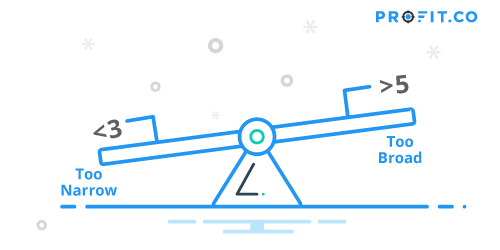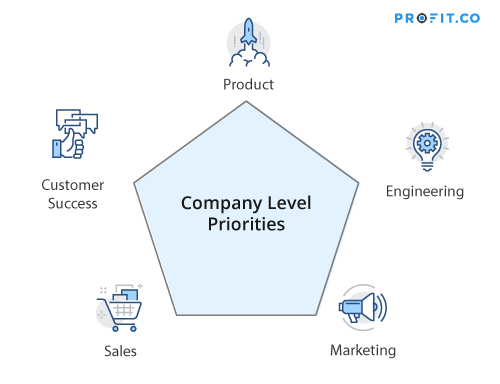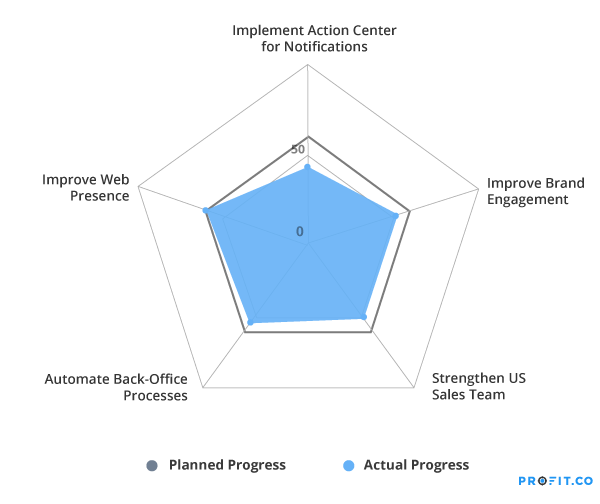If you have been researching the OKR framework, you may have heard that the ideal number of objectives and their corresponding key results is between three and five– 3-5 objectives, and 3-5 key results per objective. You could call this the rule of five, since many agree that this is the sweet spot for OKRs.
However, you might find yourself asking: why is this the case?
At every level of a business at which you set OKRs- corporate, departmental, cross-functional team and individual- the rule of 5 holds true. Let’s take a closer look at why 3-5 OKRs is best.
Why do I need 3-5 OKRs?
The simple answer to this question is “focus”. Focus is one of the key tenets of the OKR methodology.

By focusing on between three to five objectives, and limiting your number of key results to this range, the OKR framework offers a reasonable list to operate with.
If you have more than five OKRs, it can work against you in major ways. A lack of focus has the potential to stall progress and limit success in your business. If you have less than three OKRs, though, you’ve narrowed down your line of sight so much that any progress you make will be one-dimensional. While limiting the scope of OKRs can be beneficial, going too narrow may not be appropriate or useful for your business.
The rule of five isn’t actually a hard and fast rule– it’s more of a guideline. However, OKR champions all agree that this bracket will help you and your team focus, while also helping you drive productivity in multiple areas, meaning you’re making multi-dimensional progress that has a real impact in your business.
All businesses that implement an OKR program usually have the same end result in mind: achieving their goals and helping their company succeed. To determine if this end result is met, many people undergo the reflect and reset process at the end of the quarter. While this process is useful, it’s not the only way that businesses can see OKR progress.
There are visible signs that can help you determine if your OKR program is working correctly at any point throughout the quarter. One of these signs is balanced progress between OKRs.
Balanced progress in your OKR program means that all company OKRs are progressing at an equal pace. This reflects how well your team is performing across the board. Comparing actual progress to planned progress is useful in determining how effective your planning was, as well ashow effective your execution is.
A Closer Look
Let’s look at an example.
At the company level, you might have a balanced plan that consists of five well-developed OKRs. Each one focuses on a different aspect of the business– product, engineering, sales, marketing, and customer success.

An OKR champion can tell you that the key to a healthy OKR program is frequent check-ins and meetings. When discussing the progress of these five OKRs mid-quarter, planned progress might be at 40%, while actual progress is also at 40%. Alternatively, maybe one OKR has exceeded progress– reaching 50%-60% completion while planned progress is 40%. Meanwhile, another OKR is lagging behind– not even reaching the planned progress mark.
Even though one OKR is progressing ahead of schedule, this isn’t a good sign for your OKR program. This unequal progress demonstrates an imbalance between departments, and can point to larger issues within the organization. Taking a closer look at the sub-functions of departments might reveal that there are key problems within your organization that need to be resolved. If progress on OKRs is not balanced across the board, there could be issues that have to do with resource allocation, focus, or even talent.
If progress is lagging behind in one department or on one OKR, you should examine the specific department or team responsible and its sub-functions. For example, if your OKR focused on marketing isn’t meeting planned targets, take a look at all the components of that department. Are there issues within event marketing? Inbound marketing via content? Outbound marketing? Email messaging? Try to get to the root cause of the issue.
When you identify the key problem areas within your organization, you need to address them. These lower-level problems can greatly impact the progress of higher-level OKRs. Ensuring that you dedicate time and attention to these problem areas might seem time-consuming, however these issues have the potential to derail your goals, making it vitally important that you address issues where you see them– even if they seem to be lower-order concerns.
Monitoring progress of OKRs
Unbalanced progress of your OKRs can indicate larger issues can cause major roadblocks on key result progress. Taking the time to examine OKRs that are lagging behind in progress is very important. In order to examine these lagging OKRs, however, you first need to be able to identify them.
To help monitor your progress, Profit.co has included a simple, yet comprehensive radar chart on your OKR dashboard. This displays both planned and actual OKR progress on one concise chart that helps you quickly identify problem areas in your OKR program.
This radar chart displays all progress within a given OKR level by plotting one point for each OKR in that level. If you have five OKRs on a certain level, the five corresponding points will connect to make a pentagon.
Within this pentagon, there will be a black line, also in the shape of a pentagon, that indicates the planned progress of your OKRs. If it’s earlier on in the quarter, the black line will make a smaller pentagon. If you’re further along in the quarter, the black line will look closer to the size of your OKR pentagon, corresponding to planned progress.
Finally, you will see a shaded blue area that represents actual progress. In this example, this blue area will have five points, each corresponding to an OKR. These points are color-coded based on the status of your OKR.
If your OKR is on track, it will be green. If it’s at risk, it will be orange. If it’s in trouble, it will be red. If each OKRs’ progress is on target as planned, the blue area will fill the radar chart shape to the black line. If there is unbalanced progress, some points of the shape will be extended further than the others, creating an uneven shape. If progress on one OKR is lagging, that point will be farther behind the black planned progress line, indicating there’s an imbalance of progress.
Being able to identify balanced and unbalanced progress is important– however, the purpose behind this is so that you can dig deeper into the causes of your OKR progression.
This radar chart demonstrates balanced progress between five OKRs at corporate level.

As you can see, these OKRs are all progressing as planned, and none are pulling ahead over the others, or lagging behind.
There are a few reasons this might be happening, and it’s important to meditate on these reasons so that you can try to replicate this success in other departments, or in future quarters. Take some time during the learning stage of your PEEL cycle to reflect on what went right. Here are some examples of what that might look like:
1. Even talent distribution
Not every member of your company’s team will have the same talents. That’s why it’s important for managers to recognize every individual’s strengths and areas of improvement, and ensure that peer talent complements one another as they work towards common goals.
If a radar chart shows this balanced progress, it might be a good indicator that team members are working well together, and all individual talents are being put to good use.
2. Well-developed OKRs
Sometimes, as companies set OKRs and determine their quarterly targets, they can turn stretch goals– which are encouraged– into downright unrealistic goals. When this happens, progress might lag behind and demoralize employees.
However, if your actual progress correlates with your planned progress, this is a good indicator that you have read the capabilities of your company, department, or team correctly. This signals to realistic goals, clear objectives, and substantive key results. This could be the result of a mature OKR program, or simply a well-developed set of OKRs.
3. Committed Employees
When progress is balanced, it could indicate the commit level of the individuals responsible for those OKRs. The OKR framework requires users to demonstrate a certain amount of dedication and attention to the various processes that go into tracking and progressing OKRs.
If employees are committed, this means that they are prioritizing their OKRs over other projects, are checking in on a weekly basis, and are also utilizing weekly PPP meetings to get the help they need and move the needle on their important goals. This commitment can translate to well-balanced OKRs. This indicates that the OKR culture is well-accepted in your company. This suggests you have employees that understand the OKR methodology, it’s benefits, and are doing all they can to reach even the most ambitious goals.
Final Thoughts and More
There are some instances where you did everything right– you limited the number of objectives and key results, rolled out your OKR program in a smart and learning-oriented manner– but still, you’re facing unbalanced progress. What is going wrong?
By identifying the reasons for unbalanced progress, you can find a solution faster and get back on track with your OKRs. Many times, going back to the OKR basics can help you reach the root of your problem.!
- 16 Reasons your OKR Progress is Unbalanced: In this article, share the top reasons your OKR progress might be unbalanced and the causes hiding behind these effects.
- Solving Unbalanced progress at the corporate level: This case study explores five OKRs set at corporate level and how issues with the team and target can impact OKR progress.
- Solving Unbalanced Progress: Marketing Department Imbalance: This case study examines six OKRs at the marketing level and the issues that are causing an imbalance of OKR progress, as shown by the Profit.co radar chart.
- Solving Unbalanced Progress: Sales Department Imbalance: In this final case study for the Unbalanced Progress series, we’ll take a look at a sales department that is seemingly doing everything right, but is still facing unbalanced progress.
